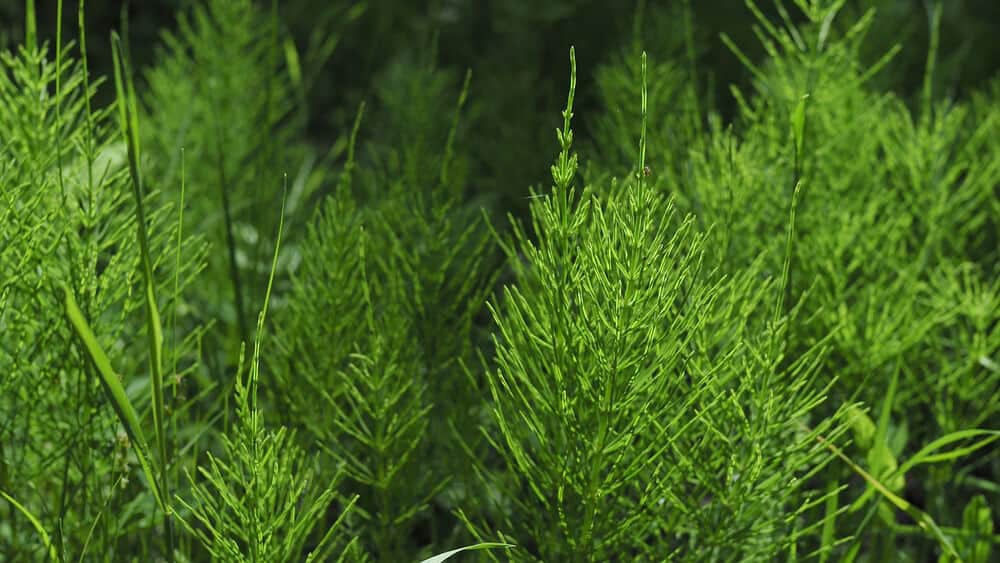Nuisance Weed Management & Control
– from Green Leaf Remediation Services
There are lots of nuisance, poisonous and invasive weeds that grow in the UK and you don’t always know they will take over when you first see them. If you have a nuisance weed in your garden or a plant that you’re not sure what it is you should always do your research or use a reputable company like Green Leaf Remediation to identify and remove it for you, ensuring it doesn’t spread further. Be aware some of these plants can be poisonous so always take extreme care when touching them.
What are the Most Invasive and Nuisance Weeds in the UK?
(These are listed in no particular order and the list is not exhaustive)
1) Japanese Knotweed
Japanese Knotweed is dreaded across the UK due to its invasive growth and its ability to spread from one tiny fragment. It can grow at an alarming rate and also go undetected, remaining dormant underground for long periods of time, especially in the winter months. People often think they have removed Japanese Knotweed themselves not realising it is growing quickly and extensively underground. There are laws and legislations around the removal of Knotweed and you should always use a specialist like Green Leaf Remediation who have the qualifications, experience and chemical experience to remove it effectively.
2) Himalayan Balsam
Himalayan Balsam is a highly invasive, non-native nuisance weed. It is illegal to grow or encourage the growth of it and you can face criminal charges even if it is grown accidentally. There are strict rules and guidelines for the removal and movement of Himalayan Balsam soil due to its ability to spread and grow extremely quickly. If you think you could have Himalayan Balsam at your property or development site then you should get a site assessment from a nuisance weed expert like Green Leaf Remediation Services who will be able to identify and advise you of the best course of action.
3) Wolfsbane
Wolfsbane belongs to the plant genus Aconitum, a group of plants that are all poisonous. The purple coloured Wolfsbane looks harmless enough and many times people see it as a colourful plant in their garden, rather than of its poisonous nature and it is often overlooked and allowed to continue growing. It is known to be one of the most toxic plants found in the UK and the toxins can cause the heart rate to slow which can be fatal and eating a very small amount can lead to an upset stomach. Poisoning cases are rare, however, many people will see it as a beautiful purple flowering plant and are unaware of the hazard in their garden.
4)Hedge Bindweed
Hedge Bindweed is an aggressive climbing weed that can exceed 3 meters in height. It quickly grows and twists its way through other plants in the process and this makes it extremely difficult to remove without damaging the plants around it. South Wales Knotweed are experienced in all types of nuisance and poisonous weeds in the UK and are able to quickly identify and remove them for you.
5) Himalayan Knotweed
Himalayan Knotweed is a member of the Polygonaceae family and is often mistaken for Japanese Knotweed. It has the same characteristics as Japanese Knotweed in that it grows quickly and is easily spread from one tiny fragment. You should always use a specialist to identify and remove Himalayan Knotweed as they will know and understand the method of removal that will ensure it doesn’t return, as well as be qualified to carry out the treatment and understand the legislation.
 6) Horsetail
6) Horsetail
The Horsetail weed can grow as deep as 1.5 meters into the ground and will quickly grow out of control if it is not managed effectively. If it’s broken or damaged in any way it will re-grow and rejuvenate extremely quickly which causes a lot of issues for many gardeners and property owners. It is a poisonous weed that is highly dangerous to grazing farm animals and plantations which creates lots of headaches for farmers all over the UK.
7) Common Ragwort
Common Ragwort spreads via the air and wind which makes it very difficult to manage and to prevent it from spreading. Once carried by the wind, Ragwort seeds can remain active for up to 15 years meaning their growth is extremely difficult to manage if not dealt with by a nuisance weed specialist.
8) Hairy Bittercress
Hairy Bittercress is a common nuisance weed found in many gardens in the UK. When it flowers its seed pods fire out and can and cover and propagate a huge area and this is how it reproduces continuously and spreads. If you think you may have Hairy Bittercress we can come out and identify it for you and advise you of the different control methods to effectively remove it for you.
9) Deadly Nightshade
Deadly Nightshade is a shrubby looking weed with purple bell-shaped flowers so it can sometimes be mistaken for a nice plant to have in your garden. It is most common in central and eastern England, however, there have been some cases found in other areas of the UK. It is very very poisonous and can cause dilated pupils, loss of balance, and hallucinations, as well as convulsions and convulsions in serious cases. Always ask an expert nuisance weed specialist to identify if you have Deadly Nightshade and advise you of the best and most successful removal method.
10) Hogweed
Hogweed which is also known as Heracleum sphondylium is mostly found along hedgerows, roadside verges, waste ground and rough grassland and causes huge problems to councils and local authorities. Its creamy-white flowers are umbrella-like clusters and often look very pretty, however, it quickly spreads and will take over the other vegetation around it, making it a nuisance weed.
11) Giant Hogweed
Giant Hogweed, also known as Heracleum mantegazzianum is extremely poisonous and should never be touched as the furanocoumarins contained in the sap can cause severe burns, blisters, and skin irritation when exposed to UV rays. Giant hogweed is in the parsley plant family and is listed under Schedule 9 of the Wildlife and Countryside Act 1981 with respect to England and Wales. This schedule means it is an offence to plant or allow it to grow in the wild or onto another property or land. There is strict guidance and legislation which covers the control of giant hogweed and you should always use a specialist like South Wales Knotweed to identify and remove it as well as be very aware of the dangers to your skin if it is touched.
12) Nettles
Stinging nettles stems and leaves are covered by tiny hair-like structures which are hollow and when in contact with the skin they act like tiny sharp needles and allow chemicals to flow through them into the skin causing a sharp sting feeling and red rash to appear. Stinging nettles are really difficult to remove without damaging the surrounding vegetation and a specialist like Green Leaf Remediation can help you control the spread of them.
13) Brambles
Brambles are rough prickly weeds that spread quickly, entwining themselves between other plants. The positive of bramble is that it grows blackberries, raspberries or dewberries. The more established brambles become the thicker their stems and thorns are and this makes it difficult to remove without scratching and harming your skin. Brambles are a hardy plant and will quickly become a nuisance as they grow strong suckering roots amongst hedges and other plants and are extremely resilient to pruning and being completely removed.
14) Buddleia
Buddleia which is also known as the “Butterfly Bush” is an invasive nuisance weed that has quickly spread and established itself through the UK rail network. The wind spreads the seeds as well as the low-pressure drag created by the movement of trains and this has expedited its spread. It can also infest quarries, urban wastelands, gravel workings and building sites and requires a specified herbicide treatment by a qualified specialist to control and remove it. When the weed has been treated with the herbicide its branches and trunks become brittle and they become easy to pull from the ground enabling it to be removed and transported.
15) Dock
Docks are highly persistent perennial weeds that are generally found on agricultural land and recently disturbed land or gardens. Many of us don’t realise how they will spread and how difficult they are to remove. Docks are extremely deep-rooted and are able to regrow from just the top section which produces large amounts of seeds, making them highly spreadable as well as difficult to remove. The root they regrow from has to be carefully dug out of the ground and then killed using chemicals or completely submerging them in water to eradicate them for good.
16) Bracken
Bracken is one of the most successful ferns and some people like the look of it, however, it is highly invasive, can survive in acid soil and quickly colonises an area. Bracon is most often found on moorland or similar landscapes. Large triangular fronds grow from their fast-growing underground root and can form dense thickets that are difficult to remove. Having roots that sink a metre or more and that are between fronds makes removing and controlling it tricky without special knowledge.
17) Hedge Parsley
Hedges parsley is a nuisance weed that grows extensively in grassland. This plant produces a few light sprinkles of white flowers and is pretty to look at, although it spreads widely and will quickly colonize an area. Hedge Parsley sprouts early in the spring and the clusters of tiny white flowers develop seeds with burs. These burs cling to animals fur and our clothing and this as well as its seeds enable it to spread quickly. Hedge Parsley often needs a herbicide treatment to control and remove it effectively.
18) Cow Parsley
Cow parsley is usually seen at the wayside, however, if it is allowed to flower it can be highly invasive and spreadable in orchards, paddocks, churchyards and other grassed type areas. Cow parsley flowers in May and often establishes itself among white hawthorn, looking springlike and pretty. Its appearance may not seem like it but it is a weed and it will spread quickly if given the chance and not controlled.
19) Gorse
The gorse plant forms thick thickets of dense, invasive spines. It is a relentless and aggressive nuisance weed once established and it will grow over the plants surrounding it. It is seen as a fire hazard in hot countries as it holds onto its dead and dry branches and leaves for a long time.
South Wales Knotweed are experts in the growth and removal of invasive, poisonous and nuisance weeds. We will come out to your property or site and identify the plant and can then advise you of the best and most effective removal options.
We also provide tree services, such as pollarding, crowning, pruning, felling, through our NPTC chainsaw operators, all of whom possess a vast amount of experience in the forestry industry.
Our Qualifications & Accreditations
-
- City & Guilds NPTC Level 2
- Principles of Safe Handling & Application of Pesticides (PA1/PA6)
- Principles of Safe Handling & Application of Pesticides near water (PA6AW)
- Herbicide Stem Injection
- Property Care Association
- The Control & Eradication of Japanese Knotweed Surveyor’s Training Course
- Qualified Technician (PCAQT) in Japanese Knotweed
- Accredited Surveyor in Japanese Knotweed
Contact us today on 01269 591651 or 07531 142316 and we can answer any questions you may have around any Nuisance Weeds and arrange your site visit.

Martyn works for Green Leaf Remediation as a marketing specialist. He takes great pride in creating quality content regarding Japanese knotweed.
